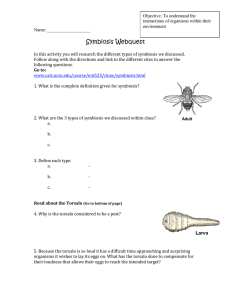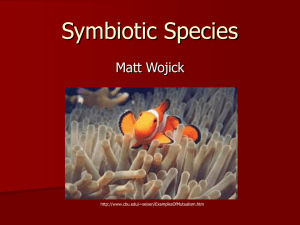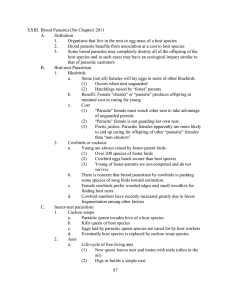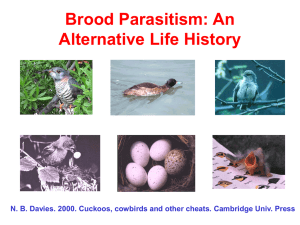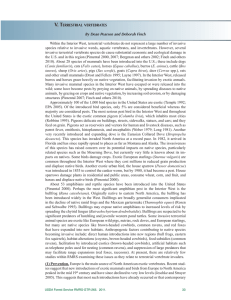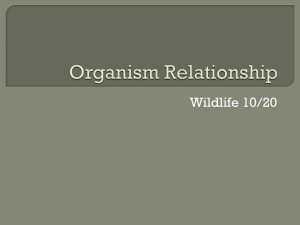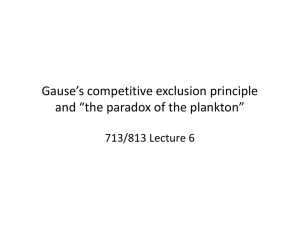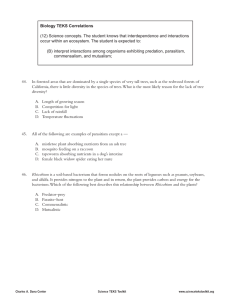Document 11863555
advertisement
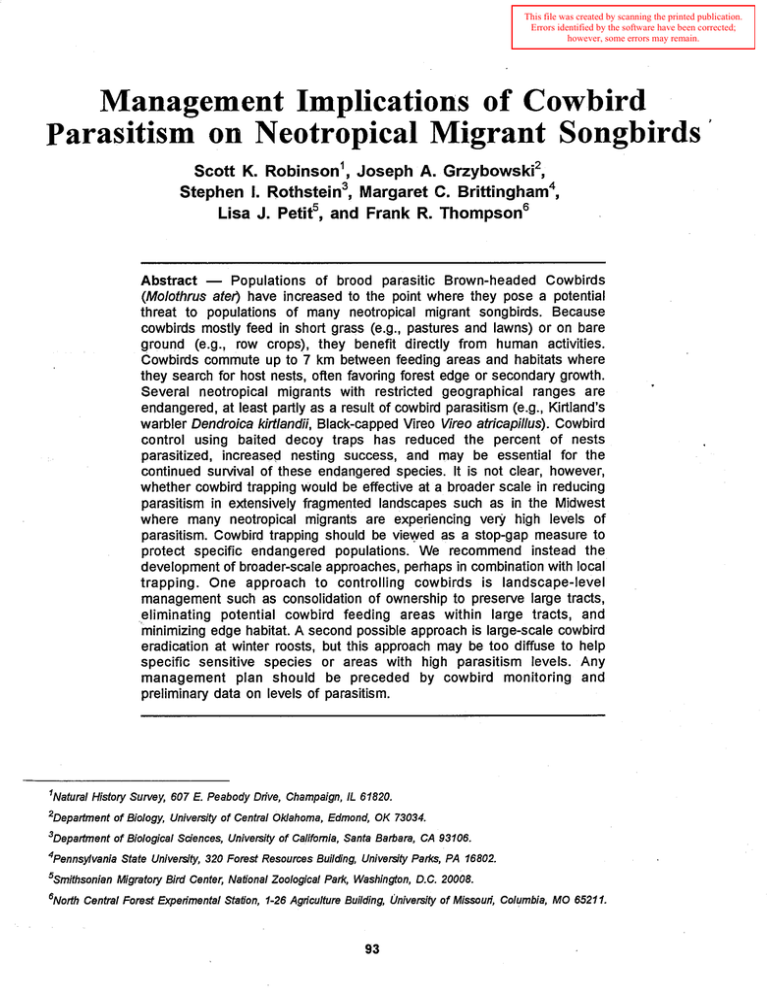
This file was created by scanning the printed publication. Errors identified by the software have been corrected; however, some errors may remain. Management Implications of Cowbird Parasitism on Neotropical Migrant Songbirds ' Scott K. Robinson', Joseph A. ~ r z ~ b o w s k i * , Stephen I. Rothstein3, Margaret C. ~rittingham~, Lisa J. petit5, and Frank R. ~hompson' - -- -- Abstract - Populations of brood parasitic Brown-headed Cowbirds (Molofhrus afer) have increased to the point where they pose a potential threat to populations of many neotropical migrant songbirds. Because cowbirds mostly feed in short grass (e.g., pastures and lawns) or on bare ground (e.g., row crops), they benefit directly from human activities. Cowbirds commute up to 7 km between feeding areas and habitats where they search for host nests, often favoring forest edge or secondary growth. Several neotropical migrants with restricted geographical ranges are endangered, at least partly as a result of cowbird parasitism (e.g., Kirtland's warbler Dendroica kirtlandii, Black-capped Vireo Vireo atricapillus). Cowbird control using baited decoy traps has reduced the percent of nests parasitized, increased nesting success, and may be essential for the continued survival of these endangered species. It is not clear, however, whether cowbird trapping would be effective at a broader scale in reducing parasitism in extensively fragmented landscapes such as in the Midwest where many neotropical migrants are experiencing verjr high levels of parasitism. Cowbird trapping should be viewed as a stop-gap measure to protect specific endangered populations. We recommend instead the development of broader-scale approaches, perhaps in combination with local trapping. One approach to controlling cowbirds is landscape-level management such as consolidation of ownership to preserve large tracts, eliminating potential cowbird feeding areas within large tracts, and minimizing edge habitat. A second possible approach is large-scale cowbird eradication at winter roosts, but this approach may be too diffuse to help specific sensitive species or areas with high parasitism levels. Any management plan should be preceded by cowbird monitoring and preliminary data on levels of parasitism. 'Natural History Survey, 607 E. Peabody Drive, Champaign, IL 61820. 2~epartmentof Biology, University of Central Oklahoma, Edmond, OK 73034. 3~epartmentof Biological Sciences, Univemity of California, Santa Barbara, CA 93106. 4~ennsylvaniaState University, 320 Forest Resources Building, University Parks, PA 16802. 5~mithsonianMigratory Bird Center, National Zoological Park, Washington, D.C. 20008. 'North Central Forest Experimental Station, 1-26 Agriculture Building, ~nivetsityof Missouri, Columbia, MO 6521 1. BACKGROUND Parasitism by the Brown-headed Cowbird (Molothrus ater) has become one of the major threats to populations of neotropical migrants on the breeding grounds (Mayfield 1977, Brittingham and Temple 1983). The Brown-headed Cowbird is a generalist brood parasite that lays its eggs in the nests of over 240 known host species (l?riedmannand Ki£f 1985), the majority of which are neotropical migrants. Historically, cowbirds were largely confined to the mid-continental prairies where they presumably followed herds of nomadic bison Cowbirds mainly search for seeds and insects in short grass and on bare ground and may have depended upon grazing by large ungulates to create suitable feeding conditions. Since the clearing of forests for agriculture and the widespread introduction of livestock, however, cowbirds have expanded their geographical range eastward and westward as new feeding ateas became available (Mayfield 1965). Similarly, cowbird populaiions have increased within their range as a result of incmsing winter food supply (primarily waste grain in agricultural fields) and higher reproductive rates as cowbirds have come in contact with new hosts that lack defenses against parasitism @byfield 1965, Brittingham and Temple 1983). Cowbird populations have continued to increase in most sections of the United States (with the notable exception of the northeast: Robbins et al. 1986). Increasing cowbird populations pose a potential b a t to many hosts because of the cowbird's extraordmq fecundity and the extent to which cowbird parasitism reduces host productivity. Female cowbirds lay at least 30-40 eggs per season on average (Rothstein et d. 1986). Dan Roby @en. c o r n ) found that individuals in captivity can lay up to 77 eggs in a season Relatively small numbers of cowbirds can therefore parasitize many nests. Cowbird parasitism reduces host productivity for the folIowing reasons: (1) female cowbirds remove host eggs (usually one) from 33% to 90% of all parasitized nests Friedmann 1963, Weatherhead 1989, Sealy 1992); (2) cowbird eggs are unusually thick an4 when laid, often break those of the host (Spaw and Rohwer 1987, Roskaft et al. 1990); (3) cowbird eggs have a short incubation period of 11 days compared with 12-14 clays for most hosts (Nice 1953, Friedmann 1%3), which gives nestling cowbirds a head start; (4) cowbirds usually parasitize hosts smaller than themselves, which gives cowbird nestlings a further advantage in competition with host young; and (5) cowbird nestlugs grow faster, beg more loudIy and have larger gapes than host nestlings (Friedmann 1929, Ortega and Cruz 1991). As a result of these factors, small hosts with long incubation periods usually fail to produce any of their own young if a single cowbird egg hatches (Rothstein 1975, May and Robinson 1985). For larger hosts and those with shorter incubation periods, cowbird parasitism is less costly (Smith 1981, Roskaft et al. 1990, Friedmann et al. 1977), except when the nests are multip1y pamitized (i.e., two or moz cowbird eggs are laid). Neotropical migrants are especially vulnerable to cowbird parasitism Most neotmpical mibuild opencup nests, which are the most frequent target of cowbirds (Friedmann 1929). The cowbird egg-laying period generally extends from mid-April until mid-July (Friedmann 1929, Scott 1963, Robinson, unpubl. data), which also coincides with the majog period of egg-laying in most neotropical m-i (Whitcomb et al. 1981). Resident and short-distance migenerally have longer breeding seasons that only partially overIap that of the cowbird. Cowbird hosts with restricted geographical ranges can be particularly vulnerable to parasitism. Cowbird parasitism is considered one major cause (dong with habitat loss) of population declines and the endangered status of the Kirfland's Warbler (Dendroica kirtlandii) (Walkinshaw 1983), Least Bell's Vireo (Kreo belli pusillus) (Franzreb 1989), Southwestern Willow Flycatcher (Empidonax lraillii extirnus) (Unitt 1987, Brown 1988), and Blackcapped Vireo (Mreo atricapillus) (Gnybowski et al. 1986). Cowbird hosts with larger ranges may be less wlnerabIe because heavily parasitized populations can be "rescued" by immigrants produced from populations in areas where parasitism levels are lower. Local extinctions of wide-ranging species, however, have occurred im Oklahoma (Orchard Oriole, Icterus spun'us) (J. Gnybowski, pers. obs.) and in the lower Rio GraTlde Valley (J. Arvin, pers. corn) and may be linked to heavy parasitism The pamitic life history of cowbirds enables them fo occupy a wider range of habitats than any other North American passerine. Because cowbirds do not tend their own offspring, their two main activities during the breeding season, feeding and searchmg for hosts, can be uncoupled and carried out in different locations. Cowbirds can therefore occupy habitats that fulf~ll only one of these needs (Rothstein et al. 1984) and regularly commute up to 7 km between feeding and nest-searching sites (fig. 1, see also Rotkstein et al. 1984). In southern Illinois and central Missouri, for example, cowbirds that searched for nests in forests fed 0.1-4.0 lun may in pastures, feedlots for livestock bigs, horses, and cattle), mowed roadsides, lawns, recently plowed and planted row crop fields, campgrounds, gravel roadsides, bird feeders, and logging roads (fig. 1). In the Sierra Nevada of California, recently arrived cowbirds commuted on average once a day between horse corrals and feeding areas. Rothstein et al. (1984) estimated that this single corral made it possible for cowbirds to parasitize hosts over an area of 154 km2 that contained no other suitable feeding sites. In southern Illinois, where there are many potential feeding sites, cowbirds fed throughout the day (fig. 2). Perhaps because of the proximity of feeding and nest-searching areas, cowbirds tend to be most abundant in heterogeneous "fmgmented" landscapes in which grassy areas are intermixed with shrubby old fields andlor forests. Cowbird control may be much more diEcult in landscapes where human activities have created many potential feeding areas (Rothstein et d. 1987; see below). I 1 , ,' Roosting to Breeding 40 9 c 80 Breeding to Feeding Hour I3Short Grass II13Tall Grass Crop Land E3 Feedlot HShrub-Sapling Forest El DevelopedW Unknown ".' 1 Feeding to Roosting I Distance Moved (km) - Figure I. Movements patterns of breeding female Brown-headed Cowbirds in Illinois and Missouri. Movements are presented as the percent of total movements from roosting to breeding, breeding to feeding, and feeding to roosting locations in 1 Ion distance classes, and are based on 1,160 movement by 96 radio-tagged Cowbirds during 1991 and 1992 (Thompson, In Review). CONDITIONS FAVORING COWBIRD PARASITISM Numbers of cowbirds and rates of paasitism within the Eastern deciduous forest vary with distance from edges (Gates and Gysel 1978, Chasko and Gates 1982, Britthgham and Temple 1983). In an extensively forested area of Wisconsin, for example, Brittingham and Temple (1983) and Temple and Cary (1988) found that percent of parasitized nests declined from 65% within 99 m of an edge to less than 18%at >300 m. Brittingham and Temple (1983) argued that forest fragmentation leads to higher levels of parasitism by increasing the ratio of forest edge (>300 m from an edge) to forest interior (300 m h m an edge). In a modelately (50%) forested area of the Shawnee National Forest in southern Illinois, however, Robinson et al. (in review) and Trine et al. (in review) found no appreciable decrease in parasitism levels even 800 m h m the m s t edge. Apparently, - Figure 2. Diurnal patterns in habitat use by breeding female Brown-headed Cowbirds in Missouri and Illinois. Habitat use was determined from 3,584 locations of 96 radio-tagged female Cowbirds in 1991 and 1992 (Thompsorl, In Review). cowbird populations have saturated the available forest in this area In contxast, the percent of nests parasitized is low (<lo%) throughout extensively (>SO%) forested sections of the h M c Twain and Hoosier National Forests (John Faaborg and Don Whitehead, pens. comm.). Similarly, Hoover (1992) found no evidence of an edge effect in central Pennsylvania where cowbird populations are generally low. The magnitude of the "cowbird edge effect" therefore varies within and among regions, apparently in response to landscape-level variation in fragmentation and cowbird abundance. There is little information on differences between "internal" edges, such as those around clearcuts or "wildlife" openings, and "external" edges such as agricultml fields. Overcash and Rosebeny (1987) found cowbird ab-ce to be 4-5 times higher around small (<4 ha) wildlife openings in the Shawnee National Forest of southern Illinois, but have no data on nest parasitism. Don Whitehead @ers. comm.) found higher parasitism levels along cleanxts than in forest interior in the Hoosier National Forest even though there is no feeding habitat for cowbirds in clearcuts. Brittingham and Temple (1983) found that levels of pamitism were just as high near openings of 0.2 ha as they were near agricultural openings. Robinson is currently studying the effects of small (10.2 ha) openings created by selective logging on cowbird parasitism Corridors such as powerlines within forest habitats also create internal edges. Gates and his colleagues boked at whether numbers of cowbirds and levels of parasitism are higher near these openings and compared these results with natural comdors cmted by streams (Chasko and Gates 1982, Gates and GSen 1991). They found numbers of cowbirds and levels of pmitism were higher near both types of corridors, but also found higher host densities near comdors. Gates is continuing his research on cowbird use of these edges. Johnson and Temple (1990) also found that cowbird parasitism was higher near woody corridors and edges in tallgrass prairie habitat. Livestock Not surprisingly, availability of local feeding areas such as livestock corrals is associated with high levels of brood parasitism Vemr and Ritter (1983) and Rotbstein et al. (1980) found that areas near pack stations, livestock corrals, and free-ranging livestock in the Siem Nevada had higher numbers of cowbirds and parasitized nests. Cowbids were rate in areas far from m k stations or other human disb&ances. h t k Shawnee ~ational'~orest,tdemetg sbdies sbowed that ~odoirdsvisit pastures and feedlots even in the morning (fig. 2). - Figure I. Distribution and abundance of brownheaded cowbirds according to the Breeding Bird Survey. MANAGEMENT OF COWBIRDS Structure of the Vegetation Within a site, the percent of nests parasitized can vary with t h structure of the vegetation. Cowbirds are frequently observed perched or displaying at the top of dead snags. Anderson and Storer (1976), working within relatively open jack pine (Pinus banksiana) habitat, found pamitism of Kirtland's Watbler nests to be more likely when a dead snag was near the nest Brittingham and Temple (unpubl. data) found no such relationship with snag proximity in a deciduous woods. F ~ e m a n et al. (1990) also found that cowbirds were more efficient at fhding active nests in marshes with a high density of bees around the perimeter. Apparently, female cowbirds used trees as perches to locate nests and observe host behavior. Because of interspecitic difEerences in host nest placement, however, it is unlikely that changes in vegetation structm will affect incidence of pamitism for all species in a community in the same way. Thus, we are not yet in a position to recommend general ways of managing vegetation structure to reduce cowbird parasitism. Geographic Variation Levels of cowbird parasitism are not homogeneous over large geographical areas. Wood Thrushes (Hylocichla mustelina), for example, experience much greater parasitism in midwestem than in eastern North America (Hoover and Brittingham, in press) where cowbirds are less abundant (fig. 3). The same is true of Red-winged Blackbirds @gelaius phoeniceus; Freeman et d. 1990). The effects of cowbird parasitism on neotmpical m-i may therefore be most severe in the Midwest, and approaches to reducing parasitism should perbps be the focal issue izl the conservation of forestdwelling neotropical migrants in that region. Baseline Data In the cases of a few species (e.g., Kirtland's Warbler, Black-capped =reo, Golden-cheeked Warbler [Dendroica chrysoparia]) with small populations that are already threatened or endangered and are known to be severely affected by cowbird parasitism, immediate and intense management of cowbird populations may be necessary (see Cowbird Trapping below). However, because parasitism levels vary geographically for most other host species, local data on cowbird abundance, distribution, and levels of nest parasitism should be gathered to determine the extent to which cowbird management efforts are necessary. When monitoring bird populations, cowbirds should be given special attention During poh~I<ounts,cowbkls heard giving their dishctive "Iilttle"call should be recorded separately front those giving other calls. The rattle call is usually given by females (Rothstein et al. 1988), whereas the other two calls are pn'marily or exclusively given by males. Because cowbirds have a strongly male-biased sex ratio (Rothstein et al. 1986, Yokel 1989), many males present in nest-searching areas are likely to be unmated and may be searching for mates rather than nests. Females, on the other hand, are more likely to be searching for nests. The distribution a d abundance of female cowbirds is therefore potentially a better indicator of local variation in the intensity and spatial distribution of nest parasitism. It is possible that the ratio of female cowbirds to hosts detected in fixed-radius point counts can be used as a crude index of parasitism intensity at the community level. In Illhis, ratios of 0.05-0.10 cowbird fema1es:host males detected within fixed-radius point counts corresponded with very high levels (6040% of all nests) of brood pamsitism for most neotropid migrants (Robinson and Wdcove, in review, Robinson, unpubl. data). Because species vary enormously in susceptibility to -itism (May and Robinson 1985), however, census data be used to estimate parasitism frequencies for any one species. Rather, census data are best used to locate areas where is most likely to be a problem and in need of further study (see below). For this reason, census efforts should include near edges (including openings created by logging, wildlife management, and agriculture) as well as in the interior of habitats (e.g., Brittingham and Temple 1983). Data on disfribution of local cowbird feeding areas is essntid for designing and predicting effectiveness of cowbird control efforts (Rothstein et al. 1987). Radio-telemetry of provides the best data on use of both feeding and breeding areas (Rothstein et al. 1980, 1984, F. Thompson, unpubl. data), but is expensive (ca. $140/transmitter) and labor intensive. E 'IJwmpson estimated that tracking 35-40 female cowbirds fitted with lransmitters with a crew of three for a two-month period costs $25,000-35,0OO/site&ear. If telemetry is too expensive, cowbirds can be censused by visiting potential feeding sites, especially at midday and in the afternoon If cowbird feeding areas are restricted, cowbird trapping is much more likely to be effective (Rothstein et al. 1987). There are also some indications that female cowbirds may roost together even during the breeding season in some areas p.Thompson, unpubl. data), which might provide further opporhmities for local control. Once cowbirds have been determined to be present in an area, pilot studies should be initiated to obtain parasitism estimates for the most potentially sensitive species. Percent parasitism can be estimated from a sample of nests (Pease and G~zybowski,in review) or the relative frequencies with which hosts are seen feeding their own fledglings versus cowbird fledglings. If the level of parasitism is high (>25% of nests), the species most likely does not reject cowbird eggs (Rothstein 1975) and may be threatened by cowbird parasitism Once a potential threat has been established, one should then ideally assess the assumption that the presence of cowbirds is reducing host reproductive success to levels below that needed to compensate for adult mortality. The critical parameters to measure are: (1) parasitism frequency, (2) nest predation frequency, (3) frequency of abandonment of parasitized and unparasitized nests, (4) the number of host young fledged from parasitized and unparasitized nests that escape predation, (5) the length of the nest cycle, (6) the length of the incubation period, and (7) the length of the breeding season (May and Robinson 1985, Pease and Grzybowski, in review). The last three parameters can often be obtained from the general ornithological literature. The first four parameters, however, can only be obtained by hiring a crew of skilled field workers. With these data, managers can estimate the average seasonal productivity per pair, given renestings. In general, host populations must produce 2.0-2.5 young/pair/season to maintain a positive population growth rate, assuming adult and juvenile survival rates of 4040% and 20-35% respectively. As more demographic studies of color-marked populations are conducted, estimates of survival rates will improve as will our ability to estimate the productivity necessary to maintain positive population growth rates. The levels of brood parasitism that a population cantolerate (i.e., maintain a positive growth rate) vary with the parameters described above. Species with high nest predation, low abandonment of parasitized nests, long incubation periods, and short breeding season relative to the length of the nest cycle can tolerate only low levels of parasitism. Conversely, species with low nest predation rates, high abandonment rates of parasitized nests (e.g., Prairie W d l e r Dendroica discolor: Nolan 1978), short incubation periods and long nesting season might be able to tolerate high levels of parasitism. Managers should consult with researchers studying bird demographics when the threat posed by parasitism is unclear. Cowbird Trapping Trap Design Trapping cowbirds has been successfully used to manage several neotropical migrants with small populations and local geographical ranges. Cowbird trapping, however, is unlikely to be effective over large areas such as national forests, which require landscape-level management (see below). Here we summarize methods used to trap cowbirds in situations where it is most likely to be effective. Traps used for removing cowbirds are referred to as cowbird decoy traps. They are typically outdoor cages which range in size from very portable-versions with dimensions as small as 2 X 2.5 X 1.5 m to larger cages 5 X 5 X 2 m The latter size is more often used to remove large numbers of blackbirds from areas of concentration during the winter months. They can be constructed into panels which can be quickly assembled and disassembled if there is a need to move them from location to location They should also have a small side box with a removable side opening into the cage at a top comer wall no more than an arm's length deep into which cowbirds can be collected and thus removed. The basic design is described in a USDI leaflet (1973); other designs and recommendations for construction from inexpensive materials are provided. Free-ranging cowbirds are attracted to the live-decoy cowbirds in the trap and a food source, and enter through some funnel or slit entrance, normally dropped from the ceiling of the cage. Once inside, cowbirds will usually attempt to leave the trap by moving upward, but toward the side walls, rather than directly up through the funnels. Thus most, if not all never find an exit. The funnels, however, should be dropped to such an extent that cowbirds seeking an exit along the top sides of the trap have enough room to circle around the funnel, but above the funnel entrance. The funnel should have some wire mesh across it and below its top wide enough for cowbirds to pass through, but not presenting an obvious open hole when viewed from the floor of the cage. Slit designs, modeled after Austrrllian Crow traps, can also be used. Slits of 1-112" width allow a cowbird to drop through with open or closed wings, but are narrow enough to make it inconspicuous as the exit, and, because the cowbird has to fly directly upward, too narrow for the cowbird to pass through with open wings. To some extent, slit designs have been more successful in preventing escapes (D. Steed, pers. comm.). Larger cages from 3 X 2.5 to 2 m have been uniformly successful in capimiqg cowbirds. The smaller sizes have also been successful but not as successful as larger ones (Hesteherg tit P. 1985). Materials typically used are 1 X 1" chicken wine or 112" hardware cloth. One caution: Some chicken wire sold as 1 X 1" is actually 1X 1-112". This slightly larger size is large enough to allow female cowbirds, parhcularly of the dwarf race (M. a. obscurus), to escape. Panels can be constructed with inexpensive 2 X 2" boar&, and panels can be assembled using bolts with b u t t d y nuts. Designs using metal braces, PVC tubing, among other materials are possible and are more resilient to long-term deterioration, weathering and persistent predators (such as raccoons, mink, and feral cats) which may be attracted to the traps. Designs for the latter have been developed by personnel at the Kerr Wildlife Management Area in Texas (Rte. 1, Box 180, Hunt, 1IX 78024) and the Wichita Mountains Wildlife Refuge in Oklahoma (Rte 1, Box 448, Indiahoma, OK 73552). Mobile ve~sionsfor areas with roads can also be constructed on a small trailer bed. Operating the Traps Food should be placed directly under the funnel entrance, but not in large piles that may look foreign to a cowbird. Water and perches should be provided to the sides, preferably at points where the opening of the funnel entrance is not directly visible from the perch or water dish. Perches can often be hung from the cage ceiling or supported by the sides. The cage floor should be weed and grass-free at all times. Cages with the ground scraped bare in grassland or field settings will often attract and capture free-ranging cowbirds without decoy cowbirds, or even bait. Bait can be a variety of grains or other seeds including wheat, millet, cracked corn, or sunflower seeds. Decoy cowbirds should be a combination of males and females. Use of at least two female decoys with males substantially improved capture of females. Decoy sex ratios favoring females had the greatest success, with the male:female ratio of the captured population improving from 3.3: 1 to 1.37:l ( C o b d d. 1989; Beezley and Rieger 1987). The improved capture of females with female decoys far outweighs the concerns of an occasional escaping female parasitizing nests of sensitive species. By clipping the wings of female decoys, .. . escapes can be rnmmmd or made inconsequential. However, females should not be clipped to such an extent as to appear injured, as this may affect 'the capture of additional birds. Another consideration in trapping is the length of time decoy cowbirds are in the trap. Decoys held for more than two weeks may change their behavior in ways that actually deter , capture of additional cowbirds. This happens when the cowbirds in the trap show anxiety for joining potential incoming birds. Thus, decoys should be h e d , removed periodically, and replaced with recently caphued birds. Trap Placement and Effectiveness The effectiveness of individual traps in breedmg amsoften extends less than 0.8 km from the trap (Grzybowski, unpubl. data). On Fort Hood, Texas during 1991,52 traps were operated to protect a population co-g 152 scattered Blackcapped Vireo temtories (Hayden and Taz~k,unpubl. data). In the Wichita Mountains, nine traps are used to protect approximately 75 vireo temtories (Grzybowski, unpubl. data). The ratio of traps to territories of sensitive species can be even higher fir smaller and modelately dispersed groupings. Thus, unless the population of concern is small and therefore already in serious trouble, trapping must be widespread, and therefore expensive. Trap placement can play an influential role in enhancing cowbird captwe. Traps should be placed in partly open settings, near taller potential perches, but not directly under them. Colhns el d (1989) indicated that traps placed in dense riparian habitat were less effective thanthose located in open areas imrnehately adjacent to such habitats. As a general d e , traps should be placed so that a cowbird resting on the floor of the cage cannot see a potential perch through the funnel entrance. The daily movements of cowbirds may be one of the most important considerations. A strategy of effective trap placement is to place them between the cowbird feeding sites and the areas requiring protection from parasitism Many cowbirds in hilly terrain travel up or down draws and hollows or across saddles when moving between morning breeding areas and afternoon feeding areas. Traps placed at the entrances of these areas or in the saddles may be more effective in some settings. In the Wichita Mountains, Oklahoma, for example, traps placed in the middle of Blackcapped Vireo nesting areas reduced observed parasitism from approximately 70% to 30% with only a doubling or tripling of reproductive success. When traps were placed on the perimeters of the vireo nesting areas, however, the observed pasitism declined to less than 20% and seasonal fecundity increased six to eight fold above that in untrapped areas (Glzybowski 1990a). Another strategy is to place traps near cowbird feeding m a s , especially where livestock are concentrated. Capture rates of females near cattle or buffalo were 2.14 per trap day (for the initial trap operation period) compared with 0.14 per trap day away from these animals (Gnybowski 1990a). However, if livestock an? dispemd, effectiveness is compromised (Rothstein d.1987, Tazik and Cornelius unpubl. data). A modification of this approach has been used with rntational g M n g systems, a system where cattle are moved from pasture to pasture on a rotational basis. At the Kerr WMA in Texas, cattle were placed immediately adjacent to lack-capped Vireo nesting areas (containing traps) at the be&mhIg of the nesting season Capture rates of females improved dramatically for the trap closest to the cattle, observed parasitism was the lowest recorded, and vireo reproductive success the highest (Gnybowski 1990b). Capture rates at haps a~ often high at the beginning of the trapping effort, and drop substantially after an initial capture period of two to four weeks. Most of the cowbirds are normally removed in this initial period, although traps operated near cowbird feeding sites continue catching cowbirds for most of the season Cowbird Shooting Female cowbirds can be attracted to taped calls and removed by shooting. Shooting has been used in conjunction with trapping on Fort Hood (Hayden and Tazik unpubl. data), but the specific effects of shoo- were not isolated from those of trapping. A b u t 247 female cowbirds were removed, some of which may have been later trapped if not shot. Nonetheless, the technigue can be used to remove a substantial number of cowbirds, and may be useful and more cost-effective in some areas with small or scattered groupings of sensitive species. Cowbirds, however, are sensitive to activity near the traps, including extended human visitation Thus, shooting should not be conducted at the trap locations themselves. Control at Roosts Because cowbirds gather in large roosts during the nonbreeding season, they are potentially vulnerable to Iargescale control efforts (e.g., Johnson et al. 1980). Such control efforts, however, should be considered carefi~llybefore they are implemented. Previous eradication programs have had little apparent effect on national populations of cowbirds, possibly because birds from many regions gather in the same roosts. The effects of control at winter roosts are therefore likeIy to be diffuse and may not protect any specific endangered population Control efforts may also work onIy for a few years if they seIect for cowbirds that avoid large roosts. Nevertheless, control at winter roosts may offer the most practical way to reduce cowbird populations in fragmented landscapes where local trapping is too expensive. Even if many of the cowbirds killed would be from areas where they pose little threat, the enhanced productivity of host species throughout their range might increase the pool of immigrants available to recolonize areas with heavier rates of parasitism Martin (1992), however, has argued that in most areas the effects of nest predation on host population dynamics far outweigh the consequences of brood parasitism Landscape management that reduces both cowbird and nest predator populations (Temple and Cay 1988) may therefore still be the best long-term solution to preserving' populations of neotropical migrants (see below). The ethical implications of large-scale eradication of a native songbird also need to be considered before such a program is considered. Even among the authors of this paper, opinions are divided about the value of control at winter roosts. Landscape and Habitat Management Perhaps the best and most permanent way to reduce the impact of cowbirds on neotropical migrants is through landscape-level management, which can be effective at a much larger scale than trapping. Because cowbirds are frequently associated with agriculture, human settlements, and internal and external edges, the best management strategy is to maintain large m a s of contiguous habitat. Unfomtely, we q o t provide one specific guideline for minimum area requirements for reducing cowbird impacts because edge effects vary among landscapes and cowbirds can commute long distances when searching for nests (fig. 1). As a general rule, however; bigger tracts are preferable to small ones, wider riparian strips are better than narrow ones, and compact shapes are prefrable to complex shapes with high ratios of edge to interio!: Managers must dso keep in mind the landscape surrounding the area being managed. Landscapes with few feeding oppoibmities for cowbirds may not have problems with cowbird parasitism even along edges and small openings. Landscapes with abundant cowbird feeding habitat may have cowbird populations that saturate breeding habitat regardless of proximity to edge. Ultimate solutions to the increasing threat of cowbird parasitism to neotropical migrants must .involve changing land-use practices and configurations that reduce cowbird feeding areas. Below we provide more specific guidelines. Forest Habitat 1. Where possible, managers should seek to maintain and establish large areas of contiguous forest cover that include core m a s of forest interior. Estimates of areas necessary to sustain populations of neotropical migranis vary regionally. Robbins et al. (19891, for example, suggest maintaining at least 3000 ha of contiguous forest as the minimum required to retain local populations of forest songbirds in the mid-Atlantic slates. Data from moderately fragmented areas of the Midwest suggest that areas of 20,000-50,000 ha may be necessary because the landscape supports very high cowbird populations and parasitism rates remain high even two krn from feeding areas (Robinson, urgubl. data). The Biological Advisory Team (1990) of Balcones Canyonlands Habitat Conservation Plan in Texas recommended establishing tracts of 2000-5000 ha to minimize the effects of cowbird parasitism and nest predation for the endangered Golden-cheeked Warbler. We strongly recommend that land acquisition should focus on consolidation of ownership of the largest tracts within a region and the restoration of forest habitat to eliminate cowbird feeding areas. In riparian corridors, we also advocate land acquisition and restoration to provide habitat patches that are wide enough to maintain populations of Bell's Vireos and Willow Flycatchers (Smith 1977). Consolidation of ownership in large tracts is parhcularly likely to be effective in moderately fragmented landscapes where larger tracts could represent potential sources of immigrants to recolonize smaller fragments. 2. Managers should avoid agricultural or suburban developments that result in the creation of forest islands and increase cowbird populations. When agricultural and suburban development already dominate the landscape, plans should be made to retain woodlots that have compact shapes instead of ones that a~ long and narrow. 3. Within large tracts, managers should avoid any practice that creates cowbird feeding opportunities such as mowing roadsides and campgrounds, feeding birds, establishing corrals or pack stations, and allowing grazing. Lf this is not possible or practical, potential feeding sites should be concentrated as much as possible and cowbird trapping programs established. Even if cowbird w i t i s m rates are low in large tracts, the reduction of reproductive success near cowbird feeding areas might substantially reduce the supply of immigrant neotropical migrants available to recolonize smaller patches. 4. In severely fragmented landscapes where land acquisition and restoration are not possible andlor practical, site-specific trapping may be the only way to protect ~ m n a n populations t of sensitive species. Such trapping, however, is likely to be expensive because of the availability of so many feeding areas. In these habitats, trapping might be more effective when targeted at breeding rather than feeding sites. 5. In forested areas managed for timber use, Iogging practices should vary depending upon the landscape. In extensively forested areas such as the Missouri Ozarks, Thompson et al. (1992) found that cowbirds preferred clearcut edges, but were no more abundant o v e d in areas with and without clearcuts. In these areas, the kinds of logging practices used may have little impact on cowbird jmxitism levels because cowbird populations are likely to be limited by feeding habitat availability. Similarly, in severely fragmented forests with extensive feeding habitat, cowbirds might saturate the breeding habitat egardless of the method of timber harvest. Logging practices are most likely to be an important issue in moderately fragmented landscapes where opening gaps in the canopy might provide cowbirds with additional access to hosts. We recommend that low-volume, single-tree selection be used instead of group selection or small clearcuts in severely and moderately fragmented landscapes. Group selktion cuts of 0.1-1 ha have the potential to increase parasitism frequency because they m x h i z edge habitat. Data from a fragmented forest in southern Illinois (Robinson, unpubl. data) showed higher parasitism levels for some, but not all species in tracts subjected to group selection logging within the last five years. Unfortunately, we have no data on the effect of single-tree selection on incidence of cowbird parasitism. 6. If clearcuts are used, the establishment of new edge should be minimized. Clustering cuts near existing edges, making one large cut rather than many small ones, and avoiding irregularly shaped cuts might reduce parasitism 7. Logging roads and rights+f-way should be as narrow as possible and should be revegetated to avoid creating cowbird feeding habitat. Tall Grass Prairie 1. Managers should maintain and restore extensive areas of contiguous prairie habitat that include core areas of prairie interior. Land acquisition should focus on acquiring inholdings to minimize fragmentation and cowbird feeding habitat. 2. Agricultural and suburban development that creates prairie islands should be avoided. When this is noi possible, plan development to retain prairie fragments that have compact shapes. 3. Woody fence rows, snags, and corridors within a@ adjacent to prairie should be removed unless they also provide critical nesting habitat for sensitive species. Livestock Management Because pastures and feedlots provide the best feeding areas for cowbirds, research directed at methods of raising livestock that minimize feeding opportunities for cowbirds should be initiated. Perhaps feedlots could be designed to reduce waste grain. Similarly, paspasture rotations that reduce the availability of veIy sholt grass might reduce local cowbird populations. Winter Food Availability Because increased availability of waste grain in winter might be increasing cowbird survival rates (l3rittingham and Temple 1983), more efficient harvest methods might reduce cowbird populations. Decreasing availability of waste grain, however, might also reduce populations of geese and other game animals, which would create a potential conflict for managers. Concluding Comments As researchers, we feel obligated to emphasize the need for continued studies of the population dynamics of neotropid migrants. In some respects, our knowledge of the impacts of ,pasitism on hosts is still in its infancy. There have been few demographic studies of forest or grassland passerines of the kind necessary to determine how much parasitism neotr~pi~al migrants can tolerate. Similarly, there are no publishedstudies on the impacts of logging on productivity of long-distance migrants. Until these gaps begin to be filled, the management guidelines provided above should be viewed as provisional. LITERATURE CITED Anderson, W.L., and R.W. Stom. 1976. Factors influencing Kirlland's Warbler nesting success. Jack-Pine Warbler 54:105-115. Beezley, J.A., and J.P. Rieger. 1987. Least Bell's Vireo management by cowbird trapping. Western Birds 18:5562. ~iologicdAdvisory Team. 1990. Comprehensive report of the Biological Advisory Team for the Balcones Canyonlands Habitat Conservation Plan Environmental Division, City of Austin, Austin, Texas. 80 p. Brittingham, M.C., and S.A. TempIe. 1983. Have cowbirds caused forest songbirds to decline? BioScience 33:31-35 Brown, B.T. 1988. Breeding ecology of a Willow Flycatcher population in Grand Canyon, Arizona. Western Birds 19125-33. Chasko, G.G., and JE. Gates. 1982. Avian habitat suitability along a transmission-line corridor in an oak-hicko~yforest region Wildlife Monographs 82:1-41. Collins, C.T., L.R. Hays, M. Wheeler, and 19. Willick 1989. The status and management of the Least Bell's Vireo within the Prado Basin, California, during 1989. Orange County Water District, Fountain Valley, California, 53 p. Franzreb, K.E. 1989. Ecology and conservation of the endangered Least Bell's V m . US Fish and Wildlife Service, Biological Report 89(1). 17 pp. Freeman, S., D.F. Gori, and S. Rohwer. 1990. Red-winged Blackbirds and Brown-headed Cowbirds: Some aspects of a host-parasite relationship. Condor 92:336-340. Friedman, H. 1929. The cowbirds: a study in the biology of social parasitism. C. Thomas, Springfield, IL. Frklrnann, H. 1963. Host relations of the pamitic cowbirds. US National Museum Bulletin 233. Friehann, H., L.F. Kiff, and S.I. Rothstein. 1977. A firher contribution to knowledge of the host relations of the paxasitic cowbirds. Smithsonian Contributions Zoology 235. Friehann, H.,and E.F. Kiff. 1985. The parasitic cowbirds and their hosts. Proceedings Western Foundation Zoology 2226-304. Gates, J.E., and L.W. Gysel. 1978. Avian nest dispersion and fledgingsuccess in field-forest ecotones. Ecology 593371-883. Gates, J.E., and N.R. Giffen 1991. Neotropical mibirds and edge effects at a forest-stream ecotone. Wilson Bulletin 103:204-217. Grzybowski, J.A., RB. Clapp, and J.T.Marshall, Jr. 1986. Histoly and population status of the Black-capped Vireo in Oklahoma. American Birds 40:115 1-1161. Grzybowski, J.A. 1990a Ecology and management of the Blackcapped Vireo (Yireo airicapillus) in the Wichita Mountains, Oklahoma - 1990. Wichita Mountains, Wildlife Refuge. U.S . Fish and Wildlife Service, Indiahoma, Oklahoma 28 p. Gnybowski, J.A 1990b. Population and nesting ecology of the Blackcslpped Vireo - 1990. Resource Protection Division, Texas Parks and Wildlife Department, Austin, TX.39 p. Heistefberg, J.F., F.N. Garcia, and A.D. Perez 1985. Evaluating Shiny Cowbird controI techniques in eastern Puerto Rico. Progress Report, Denver Wildlife Research Center, Bird Damage Research Report No. 354, Denver. Hoover, J.P. 1992. Factors influencing Wood Thrush (HyIocichla mustelina) nesting success in a fragmented forest M.S. Thesis, The Pennsylvania State Univenity, University Park, PA. Hoover, J.P., and M.C. Brittingham. 1993. Regional variation in cowbird parasitism of wood thrushes. Wilson Bulletin (in press). Johnson, D.M., G.L. Stewart, M. Corley, R Ghrist, J. Hagner, A. Ketterer, B. McDonnell, W. Newsom, E. Owen, and P. Samuels. 1980. Brown-headed Cowbird (Molothrus ater) mortality in an urban winter roost. Auk 97:299-320. Johnson, RG., and S.A. Temple. 1990. Nest predation and bhod parasitism of tallgrass prairie birds. Journal Wildlife Management 54:106-111. Martin, T.E. 1992. Breeding productivity considerations: what are the appropriate habitat features for management Pp. 455-473 in J.M. Hagan and D.W. Johnston (eds.). Ecology and consideration of .neotropical migrant landbirds. Smithsonian Institution Press, Washington, D.C. May, RM., and S.K. Robinson 1985. Population dynamics of avian brood parasitism American Naturalist 126:475-494. Mayfield, H.F. 1965. The Brown-Headed Cowbird with Old and New Hosts. Living Bird 4: 13-28. Mayfield, H.F.1977. Brown-headed cowbird: agent of extermination? American Birds 31:107-113. Nice, M.M. 1953. The question of ten-day incubation periods. Wilson Bulletin 65231-93. Nolan, V., Jr. 1978. The ecology and behavior of the Prairie Watbler Dendroica discolor. Ornithological Mnographs No. 26. American Ornithologists' Union, Washington, D.C. Ortega, C.P., and A. Cruz. 1991. A comparalive study of cowbird parasitism in Yellow-headed Blackbirds and Red-winged Blackbirds. Auk 108:16-24. Overcash, J.L., and J.L. Rosebeny. 1987. Evaluationof Shawnee National F o ~ s twildlife openings. Final Report W-94-R, Cooperative Wildlife Research Laboratory, Southern &is University at Carbondale. 121 p. Pease, C.M., and J.A. Grzybowski. MS. A Model for assessing the consequences of brood parasitism on seasonal fecundity in passerine birds. Ecology (submitted). Robbins, C.S., D. Bystrak, and P.H. Geissler. 1986. The breeding bird survey: Its first fifteen years, 1965-1979. USFWS Res. Publ. 157, Washinglon, D.C. Robbins, C.S., D.K. Dawson, and B.A. Dowell. 1989. Habitat area requirements of breeding forest birds of the middle Atlantic states. Wildlife Monographs 103:1-34. Robinson, S.K., and D.S. Wilcove, in review. Forest fragmentation in the temperate zone and its effects on migratory songbirds. In: K. Young and M . k Ramos (eds.), The conservation of migratory birds in the Neotropics. International Council for Bird Preservation, Washington, D.C. Roskaft, E., G.H. Orians, and L.D.Beletsky. 1990. Why do Red-winged Blackbirds accept eggs of Brown-headed Cowbirds? Evolutionary Ecology 4:35-42. Rothstein, S.I. 1975a. An experimental and teleonomic investigation of avian brood parasitism. Condor 771250-271. Rothstein, S.I., J. Verner, and E. Stevens. 1980. Range expansion and diurnal changes in dispersion of the Brown-headed Cowbird in the Sierra Nevada. Auk 97:253-267. Rothstein, S.I., J. Verner, and E. Stevens. 1984. Radio-tracking confirms a unique diurnal pattern of spatial occurrence in the parasitic Brown-headed Cowbird. Ecology 65:77-88. Rothstein, S.I., D.A. Yokel and R.C. Fleischer. 1986. Social dominance, mating and spacing systems, female fecundity, and vocal dialects i n captive and free-ranging Brown-headed Cowbirds. Current Ornithology 5: 127-185. Rothstein, S.I., 3. Vemer, E. Stevens, and L.V. Ritter. 1987. Behavioral differences among sex and age classes of the Brown-headed Cowbird and their relation to the efficacy of a control program. Wilson Bulletin 99:322-327. Rothstein, S.I., D.A. Yokel, and R.C. Fleischer. 1988. The agonistic and sexual functions of vocalizations of male Brown-headed Cowbirds, Molothrus ater. Animal Behavior 36:73-86. Scott, D.M. 1963. Changes in the reproductive activity of the Brown-headed Cowbird within the breeding season. Wilson Bulletin 75: 123-239. Sealy, S.G. 1992. Removal of Yellow Warbler eggs in association with cowbird parasitism. Condor 94:40-54. Smith,F. 1977. A short review of the status of riparian forests in California. Pp. 1-2 in A. Sands (ed.). Riparian forests in California: their ecology and conservation. Institute far Ecology Publication 15. 122 p. Smith, J.N.M. 1981. Cowbird parasitism, host fitness, and age of the host female in an .island Song Sparrow population, , Condor 83:152-161. Spaw, C.D., and S. Rohwer. 1987. A comparative study of eggshell thickness in cowbirds and other passerines. Condor 89:307-3 18. Temple, S.A., and J.R. Cary. 1988. Modeling dynamics of habitat-interior bird populations in fragmented landscapes. Conservation BioIogy 2:340-347. Thompson, F.R, 111, W.D. Dijak, T.G. Kulowiec, and D.A. Hamilton. 1992. Breeding bird populations in Missouri Ozark forests with and without clearcutting. Journal of Wildlife Management 56:23-30. Thompson, F.R, 111. Spatial and temporal patterns of breeding Brown-headed Cowbirds in the Midwest United States. In Review. Unitt, P. 1987. Etnpido?.raxt~aiZIIiiexti~nus: an endangered subspecies. Western Birds 18:P37-162. USDI. 1973. Building and operating a decoy trap for live-capturing cowbirds and other birds. U.S. Department Interior, Fish and Wildlife Service, Twin Cities, Minn. Leaflet AC 211. 4 p. Verner, J., and L.V. Ritter. 1983. Current status of the Brown-headed Cowbird in the Sierra National Forest. Auk 100:355-368. WaIkinshaw, L.H. 1983. Kirtland's Warbler. BloornfieId Hills, Cranbrook Institute of Science. Weatherhead, P.J. 1989. Sex ratios, host-specific reproductive success, and impact of Brown-headed Cowbirds. Auk 106:358-366. Whitcomb, R.F., C.S. Robbins, J.F. Lynch, B.L. Whitcomb, K. Klirnkiewicz, and D. Bystdc. 1981. Effects of forest fragmentation on avifauna of the eastern deciduous forest. Pp. 125-205 in R.L. Burgess and D.M. Sharpe (eds.), Forest island dynamics in man-dominated landscapes. Springer-Verlag, New York. Yokel, D.A. 1989. Intrasexual aggression and the mating behavior of Brown-headed: their relation to population densities and sex ratios. Condor 91:43-51.
